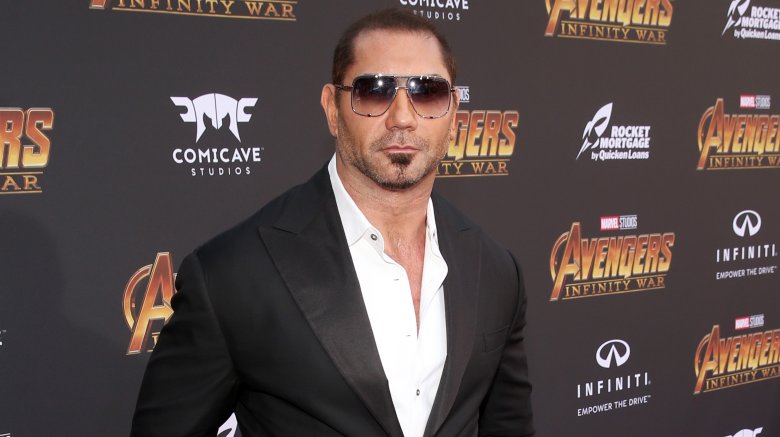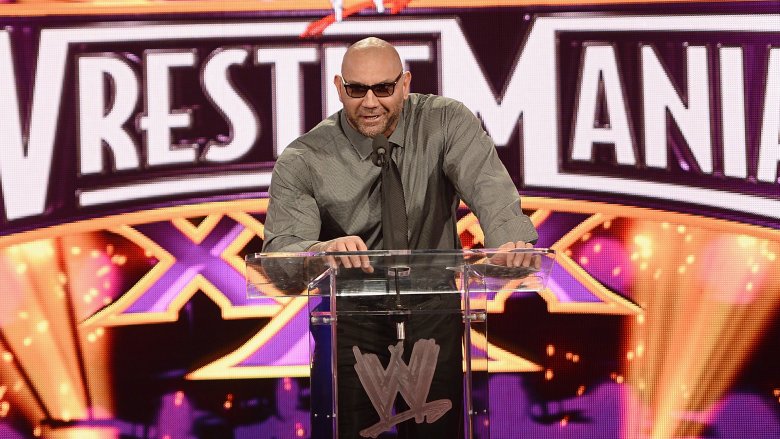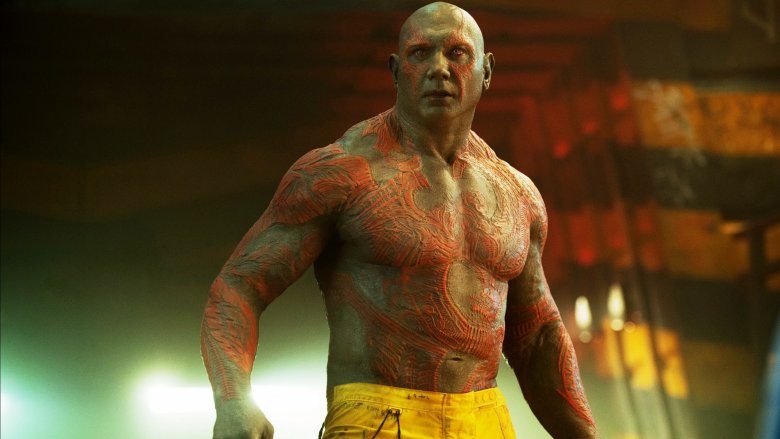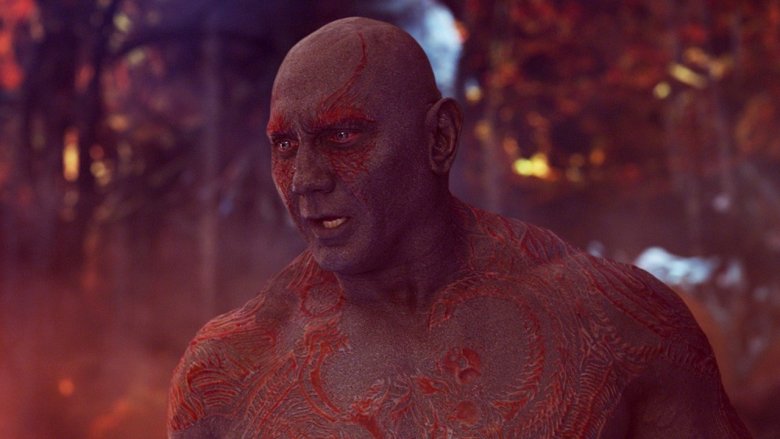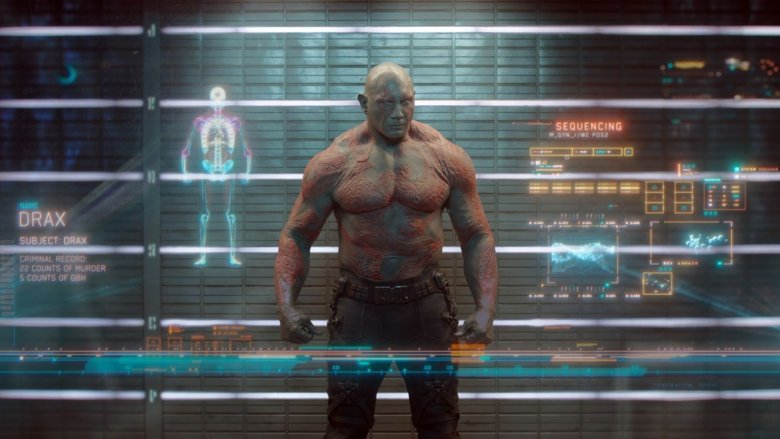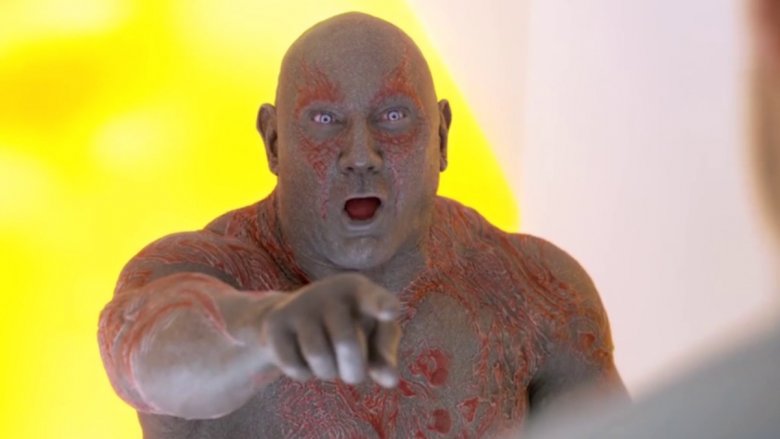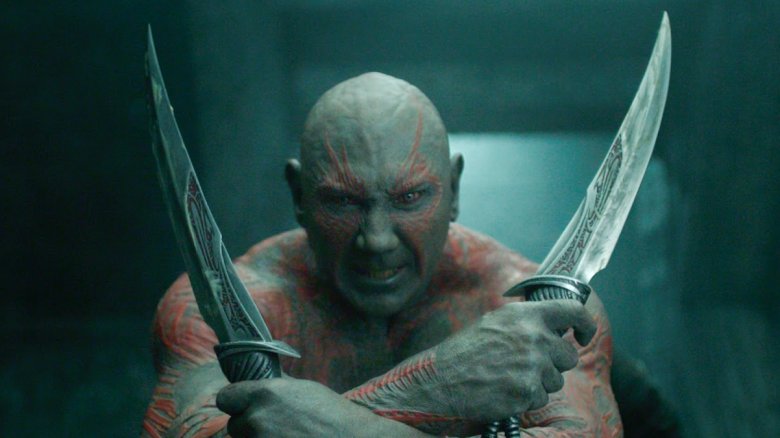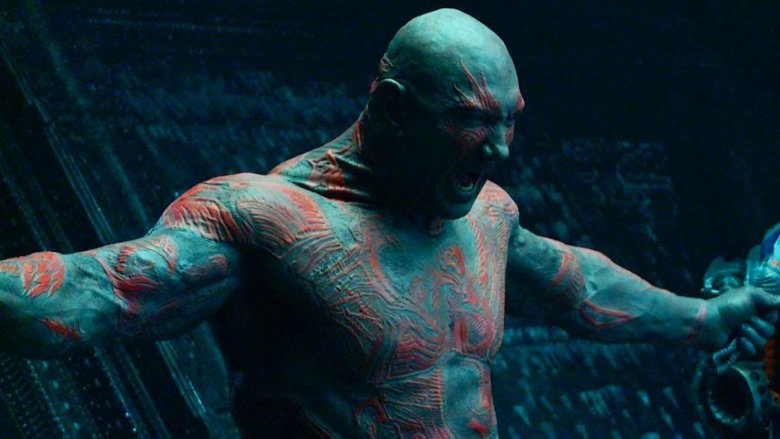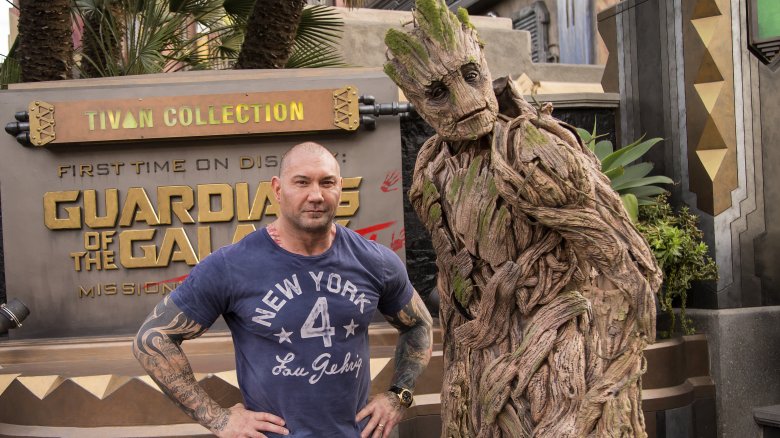How Dave Bautista Transformed Into Drax
As an internationally renowned wrestler, body builder, and mixed martial artist, Dave Bautista's body has always been his instrument. He's the type of guy who walks into a room and becomes the focus of attention. It is this imposing physicality that so drives his performance as Drax the Destroyer, the Guardians of the Galaxy's own innuendo-missing, monster-chopping, lovable brute-for-hire. Despite the fact that his steely sinews are on lavish display — Drax is no fan of shirts — Bautista's muscles aren't the focal point of the character's design.
No, the audience's eyes are first drawn to the unnatural grey-blue of his skin, the raised red tattoos covering his chest, and his bright blue eyes. Just how do the special-effect magicians of Marvel transform a titan of the ring into an extraterrestrial soldier of fortune? The answer involves a lot more dental fakery, time in the sauna, and prosthetic sheeting than you might guess.
It begins with a mold of his torso
Any artist will tell you that practice is key to mastery. But how does one practice as a makeup artist, when one's canvas must eat, sleep, and presumably live life outside the makeup chair once in a while? The answer: make a model, and go to town on it. This is very much the case when it comes to Bautista's transformation into Drax, which begins with a model of his body. As Drax spends most of his time shirtless, the model includes his head, face, arms, and torso, down to his hips.
From this, the makeup team creates a "Vac forma" — essentially a clear plastic mold with holes punched into it to indicate where Drax's many tattoos and scars must be created. The plastic mold is placed on Bautista at the start of his makeup session, and a type of rice paper-based special effects makeup known as "Skin Illustrator" is airbrushed through the holes. The result is a map of where Drax's tattoos should be placed with an impressive level of precision, allowing the artists to access a portable, easily replicated basepoint from which to start. Given the massive production process required for the Guardians of the Galaxy and Avengers movies, this level of precision is essential to maintain continuity with a visually complex character like Drax.
A base skin tone is painstakingly created
Quick, try to remember what color Drax is. You might think this is a softball question, but look up a picture of him, and you'll realize it's a good bit more complicated than it seems. Is he blue? Grey? An in-between sort of greyish-blue? Compare how he looks in the sterile light of a spaceship to the warmer sunlight of Ego's home in Guardians of the Galaxy Vol. 2. Answering with any sort of specificity is difficult — and as it turns out, that's very much by design.
Bautista's body paint odyssey begins with a base level of grey. But if you guessed that Drax is grey, don't rejoice just yet. Just as a person with pale skin can find tones of red, pink, and brown on their body, so too do Marvel's makeup artists seek to complicate Drax's skin. "We added thin layers of browns, reds, and greens within the base grey to break up the tone and make it come alive before the final color sweep," makeup effects designer David White told Business Insider in 2014. Take another look at Drax, and this level of detail becomes obvious — the green, brown, and even red worked into his alien complexion are subtle, but present. Infinity War and Endgame, which placed Drax beside far more human characters than ever before, made the artistry behind his design truly pop. He might look totally inhuman, but it's the human touches that add polish.
Time for tattoos
With Drax's overall skintone achieved, the makeup team then tackles his prosthetics. Despite the fact that Drax's overall look seems relatively simple compared to the army of intricate Iron Man armors, the striking gold vibrancy of Ayesha, or the photo-real CG behind Thanos, the intricacy of his tattoos does present a challenge. They're not quite like traditional tattoos, being raised and a fairly consistent shade of red. Yet neither are they as random as battle damage, or as uniform as purposeful body modification a la Killmonger's extensive scarification. They are, like Drax, entirely unique and entirely alien.
To create them, the makeup artists use 18 prosthetic pieces, placed onto the areas previously mapped out using Skin Illustrator and the plastic mold of Bautista's body. Though the prosthetics are incredibly thin, wrinkling and buckling presented issues to the original Guardians team, pushing the sequel's artists to shave them down to the thinnest layers possible. Once applied, makeup is used to blend the prosthetics into Drax's skin, and a fan brush is raked across his body, turning the raised, keloid-like tissue of the prosthetics red. Few aspects of the outrageous look of the Guardians cast have presented the special effects team with more challenges than Drax's unique tattoos — and, ultimately, pushed them into ever-more impressive levels of innovation.
The masterpiece is sealed
At this point, Bautista is looking mightily Drax-like. He's the perfect shade of slate-blue-grey. He's got his prosthetics applied, blended, and turned cherry red. He is, to the untrained eye, ready to go. But now, one of the most pernicious special effects problems rears its ugly head: how do you keep the makeup looking pristine for hours of shooting, through hot lights, capricious weather, and the wear and tear incurred by bathroom breaks and meals?
As a prosthetic makeup department head for Legacy Effects, Brian Sipe is well acquainted with the rigors faced on an MCU set. "Our enemy is heat and sweat," Sipe recounted for the Makeup Artists and Hair Stylists Local 706 website, "and we had heat from the lights, body heat from the actor, and the muggy Atlanta heat and humidity." The sealing of Drax's look has to be similarly aggressive: Bautista is brush sealed with a mixture of chemical and medical adhesive. Though this is notoriously intense way of finishing off one's look — cosplay enthusiasts warn each other in no uncertain terms about the time needed to scrub this sort of sealant off — it's Hollywood's first choice, as it truly keeps even the most elaborate looks from smudging.
Improper dental hygiene
The layman might think Drax is done once the makeup is sealed. He's the right color, he's got his tattoos, he's been locked into his look with the hardest-core sealant around. But it's the details that truly make a character design sing. Without her antennae and blank black eyes, Mantis wouldn't ride the line between adorable and just-a-tiny-bit-creepy so well. Without her pink highlights and facial grooves, Gamora might bring to mind "single stalk of asparagus" more than "fearsome alien warrior with mysterious family ties." So it goes with Drax, whose finishing touches have nothing to do with tattoos or blue body paint.
Do you remember Drax's teeth? Probably not. But special care is put into making sure they look believably gross, as a bereaved warrior's teeth would likely be. Bautista's teeth are too even and well-maintained to fit the bill, calling for a custom set of dentures to transform his pearly whites into, well, dingy greys. These allowed the crew to "dirty down his teeth," as makeup designer David White so evocatively puts it, thus getting one more piece of the puzzle that is Drax's design in place.
A piercing gaze
Teeth aren't the only subtle detail the crew paid attention to, however. Drax's eyes are just as impressive as the rest of him — and just as work-intensive. Tailor-made contact lenses transform Bautista's dark brown eyes into Drax's ice blue ones. They're the sort of unearthly shade you only really see in television or movies — a blue so bright and cold it brings neon lights and phosphorescent algae to mind, rather than anything you've seen on a human face. In addition to this unusual color, the iris is encircled with a thin band of blood red. These luminous shades bring Drax's gaze to the fore of the screen, echoing the blue, grey, and red color scheme of the rest of his body while signaling to the viewer that there are buried layers to this hulking brute of a humanoid. As they say, the eyes are the window to the soul. In this case, its a pretty messy soul seen through truly bizarre eyes.
Taking it all off
At last, Drax is truly complete. He's got his painstakingly multi-layered body paint on. He's had his prosthetic tattoos applied, blended, and brushed with brilliant red. His teeth have been grimed. His eyes are appropriately piercing. He's been sealed with the toughest blend of chemicals around. He's kicked butt, taken names, chopped a few aliens into pieces, and dropped a few devastatingly blunt quips. A day's work has been completed. Now comes the final task, and it's a doozy: excavating Dave Bautista from the many blended, airbrushed, glued, and sealed layers that make him into Drax the Destroyer.
In the early days of the first Guardians of the Galaxy, the makeup up team scrubbed it all off him with brute force. But, as Bautista told CinemaBlend, two days of this treatment made his skin "like hamburger," and a better method was sought. The answer was found in a portable sauna. At the end of a day of shooting, Bautista sits in the sauna, raising his core body temperature and building up sweat, which loosens the makeup's hold on his skin. With the help of steam-pumping hoses, shaving cream, hot towels, and a silicone-based makeup remover known as 244 Fluid, Bautista is freed from Drax's carapace. He, the makeup team, and the rest of the cast and crew get to go home as humans — only to do it all again the next day of shooting.
Paring down the process
So, we know how Drax is made and unmade, how painstaking a process that is, and how the team behind his creation has perfected it to a precise routine. But what you might not realize is just how dramatically that routine has changed. Initially, on the set of the first Guardians movie, turning Bautista into Drax took a tedious five hours during which he, with the help of armrests, had to stand as still as possible. Taking the makeup off was another journey unto itself, taking roughly two hours.
The Guardians sequel saw a dramatic streamlining of the process. His prosthetic tattoos were reduced in number from 27 to 18. The sauna was introduced, and removal fell to 70 minutes. "It's so easy, you wouldn't believe it. I'm not kidding," Bautista told ScreenRant on the set of Vol. 2. "It takes like an hour and a half now. The last one, they got it down to four hours and everyone was celebrating. This, literally they attack me with paint rollers all over. And it looks better too. It looks way better." What changes might the team make once Guardians 3 rolls around? No one knows, but it seems safe to say that Bautista and the film's makeup and special effects artists will continue to impress.
